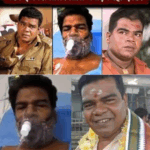Kanpur Police Scandal: CCTV Footage Reveals Officers Guiding Criminal’s Escape, Triggering Outrage
On the sweltering afternoon of June 12, the routine business of law enforcement in Kanpur Nagar took an unthinkable turn. As a police party prepared to swoop down on notorious gangster Anoop Shukla—wanted in connection with the Dhiraj Gang’s string of violent crimes—two of Uttar Pradesh’s own officers inexplicably signaled him to flee. The entire episode was captured on a nearby CCTV camera, and when the video went viral ten days later, it laid bare a shocking betrayal of the public trust by those sworn to uphold the law.

In the days since, Kanpur Police have scrambled to contain the fallout. The station house officer and his subordinate have been suspended; an FIR has been filed; and a departmental inquiry is underway. Yet for residents of this industrial city, the disgrace runs deeper than disciplinary action. How often have citizens placed blind faith in those who patrol their streets, only to discover that the danger lies in our own ranks? And how many criminals have walked free, shielded by uniforms stained with corruption?
The Moment of Betrayal: CCTV Captures the Unthinkable
The damning footage begins in the narrow lane beside the Nawabganj police outpost. At precisely 2:45 PM, Sub-Inspector Aditya Vajpayee and Constable Vijay Raj arrive on a motorcycle, their eyes scanning for Anoop Shukla, alias “Bunty.” Moments later, Bunty emerges from a rented house carrying a black suitcase—an unmistakable sign that he has been tipped off about the impending raid.
Rather than pounce, the officer in charge locks eyes with the accused and casually signals him to hurry. With a flick of his wrist and a tilt of his head, Sub-Inspector Vajpayee seems to urge Bunty to “move on,” as if dismissing him from the premises. Bunty, nonchalant and almost appreciative, waves back before melting into the maze of backstreets. Only twenty seconds later, the rest of the raiding party arrives, guns drawn and adrenaline high, only to find the house deserted and all evidence vanished.
That grainy video clip, barely a minute long, spread like wildfire across WhatsApp groups and social media pages. Viewers recoiled at the sight of an officer—a representative of state power—actively abetting a criminal’s getaway. In one afternoon, the thin veneer of authority was torn away, exposing the rot beneath.
Anatomy of a Cover-Up: What Really Happened on June 12
To understand the full gravity of the event, it is crucial to reconstruct the timeline:
-
2:00 PM: Intelligence reports reach the Nawabganj and Kohna police stations that Anoop Shukla, wanted for extortion and multiple assaults, is holed up in a rented flat on Ashok Nagar Road.
2:15 PM: Station House Officer (SHO) Inspector Sanjay Verma briefs his team. Sub-Inspector Aditya Vajpayee and Constable Vijay Raj are assigned to cordon off escape routes.
2:30 PM: As officers move in, Vazpayee and Raj—contrary to orders—tip off Bunty about the operation by calling his mobile phone multiple times. According to call detail records obtained by investigators, these calls lasted several minutes.
2:40 PM: CCTV footage shows Bunty retrieving a suitcase from the flat and waiting for a clear path to flee. Outside, Vajpayee revs up his motorcycle, ready to ferry the gangster away.
2:45 PM: The fateful signal is given. Bunty escapes unchallenged. Ten seconds later, the rest of the team arrives; the raid collapses in chaos.
2:55 PM: Bunty uses a back entrance to slip into a waiting car driven by an accomplice, disappearing into Kanpur’s sprawl.
Within hours, word of the foiled operation spread through the criminal underworld. Bunty’s associates gloated over WhatsApp: “Our boys inside the police station are on duty.” It wasn’t a boast without basis—but a confession that hollowed out the very notion of police protection.
The Fallout: Suspension, FIR, and Departmental Inquiry
When the CCTV footage went public on June 22, Commissioner of Police Akhil Kumar was forced to respond. In a curt statement, he announced the immediate suspension of Sub-Inspector Aditya Vajpayee and Constable Vijay Raj. Both face charges of criminal conspiracy, dereliction of duty, and aiding and abetting a wanted person.
An FIR has been registered under Sections 120B (criminal conspiracy), 166 (public servant disobeying law), and 212 (harboring or concealing offenders) of the Indian Penal Code. The investigation is now being overseen by Additional Commissioner of Police (Karolganj) Shilpa Mishra, with a deadline to submit a report within one week.

Despite these measures, public confidence remains shattered. Local residents staged impromptu protests outside the Nawabganj outpost, brandishing placards that read, “Police or Protectors of Crime?” and “Stop Shielding Gangsters.” Social media channels brimmed with sarcastic memes, #KanpurPoliceShame trended on Twitter India, and even veteran journalists lambasted the UP administration for repeated lapses.
Police Department’s Denials and Attempts at Damage Control
In the days following the scandal, Kanpur Police have attempted to shift the narrative. Initial official assertions labeled the CCTV footage “incomplete” and “misleading.” A senior officer, speaking on condition of anonymity, blamed “technical glitches” and “poor lighting” for the apparent signal from Vajpayee to Bunty. The department also suggested that Bunty was well-known to local residents, and might have slipped past officers simply because of the area’s dense population, not due to collusion.
These denials have only fueled public cynicism. Media outlets pointed out that the footage was timestamped, high-definition, and unambiguous. Independent cyber experts verified its authenticity within hours. Meanwhile, calls for a higher-level judicial inquiry grew louder. Opposition politicians demanded that the case be transferred to the Central Bureau of Investigation (CBI), arguing that local police could not be trusted to investigate their own.
The Human Cost: Fear, Betrayal, and a City on Edge
For ordinary citizens of Kanpur, this scandal is not merely about one botched raid; it’s a wrenching reminder that safety can no longer be taken for granted. Shopkeeper Ramesh Pandey, who watched the video unfold on his phone, described the moment he realized police officers were the enemy: “I freeze any time I see a patrol car now. I wonder: who in that car is wearing a badge, and who is wearing a mask?”
Women traveling alone in the city’s buses have reported heightened anxiety, fearful that officers posted at checkpoints could be on gang payrolls. Local taxi drivers say passengers now ask them to detour around police checkpoints, preferring to risk a longer ride over potential collusion. “If a uniformed officer waves you along,” reflected driver Sunil Sharma, “how do you know he’s protecting you and not protecting criminals?”
The victim of the botched raid, Anoop Shukla, has reportedly resumed his extortion racket. By leveraging the knowledge that he has protectors inside the force, he has sent chilling messages to local businessmen: “I’ll pay my dues to those who matter. You pay gold or blood.” With each fresh threat, the city’s sense of law and order erodes further.
Political Repercussions and Calls for Reform
The scandal has triggered a firestorm of political debate in Uttar Pradesh. The opposition Samajwadi Party accused the ruling BJP government of “institutionalized corruption” within the police ranks. Party leader Shivpal Yadav demanded a full roll-back of the Kanpur Police hierarchy and proposed a civilian oversight committee with the power to review departmental transfers and promotions.
Meanwhile, the state home minister, Brijesh Pathak, defended the force: “Two bad apples do not spoil the barrel,” he declared. “We are committed to weeding out corruption and restoring public trust.” Yet Pathak’s assurances rang hollow to many observers, given the long history of high-profile police misconduct in UP—from custodial deaths to alleged encounter killings.
Legal experts have weighed in as well. Senior advocate Neha Dubey pointed out that the misuse of power shown in the CCTV footage could violate not only domestic laws but also international conventions on policing and human rights. “When officers collude with criminals,” she wrote in a column for The Hindu, “they undermine the very foundation of the social contract. The damage cannot be undone by suspensions alone.”
Lessons Learned—and Unlearned
Every major police scandal presents an opportunity for systemic reform. In Kanpur’s case, advocates have called for:
Independent Monitoring: Installing third-party surveillance at all police stations to record officer conduct.
Whistleblower Protections: Guaranteeing anonymity and safety for honest officers who expose corruption within the force.
Community Policing Models: Engaging local residents in safety audits and patrols to reduce overcentralization of power.
Transparent Disciplinary Processes: Publicizing details of internal inquiries and their outcomes, rather than burying verdicts in departmental files.
Yet history shows that such recommendations often gather dust on bureaucratic shelves. As soon as the public attention drifts—and it will—the urgency to overhaul a system riddled with dark incentives fades. Meanwhile, the same rot that allowed Sub-Inspector Vajpayee and Constable Vijay Raj to betray their oath will continue to fester, fed by impunity and uneven accountability.
The Road Ahead: A Test of Will and Integrity
In the coming weeks, Commissioner Akhil Kumar faces a crucible moment. Will he follow through on his promise of swift, transparent justice? Or will he seek to quietly reintegrate the suspended officers once the heat subsides? Can the Kanpur Police franchise rebuild its shattered reputation, or is the trust lost beyond repair?
For now, the city watches and waits. Each morning as the sun rises over the Ganges, residents will scan the streets not only for signs of criminals, but for the familiar flit of blue uniforms—questioning whether they serve the people or shield the criminals they are sworn to arrest. The answer to that question will determine whether Kanpur can ever reclaim its sense of security, or whether fear and suspicion will become permanent fixtures of daily life.
In the end, the real scandal is not that a few officers helped a gangster escape; it is that such betrayal can take place at all. And until every badge, every weapon, and every precinct is cleansed of the corrupting influence of fear and bribes, no citizen can trust that justice will prevail. The CCTV camera captured a fleeting moment of collusion—but its ripple effects may shape the soul of the city for years to come.
News
Salman Khan’s Playful Reaction: When Vicky Kaushal Casually Proposed to Katrina Kaif
Salman Khan’s Playful Reaction: When Vicky Kaushal Casually Proposed to Katrina Kaif Bollywood has always been a treasure trove of…
Krushna Abhishek Opens Up About ‘Accidental’ Marriage, Family Ties, and Govinda Rift on The Kapil Sharma Show
Krushna Abhishek Opens Up About ‘Accidental’ Marriage, Family Ties, and Govinda Rift on The Kapil Sharma Show Renowned comedian and…
Smriti Irani’s Return as Tulsi in “Kyunki Saas Bhi Kabhi Bahu Thi 2” Sends Social Media Into a Frenzy
Smriti Irani’s Return as Tulsi in “Kyunki Saas Bhi Kabhi Bahu Thi 2” Sends Social Media Into a Frenzy After…
Nora Fatehi Spotted in Tears at Airport; Bodyguard Labels Fan ‘Chhapri’ in Viral Incident
Nora Fatehi Spotted in Tears at Airport; Bodyguard Labels Fan ‘Chhapri’ in Viral Incident Bollywood sensation Nora Fatehi, known for…
What Did Kiran Singh Say to Khesari Lal Yadav About Roshan Rohi’s Bail? Bhojpuri Industry Faces Backlash
What Did Kiran Singh Say to Khesari Lal Yadav About Roshan Rohi’s Bail? Bhojpuri Industry Faces Backlash The Bhojpuri entertainment…
Kataria Shares Honest Take on Ajju0008 and Pratibha’s Divorce Drama: Calls for Privacy and Maturity
Kataria Shares Honest Take on Ajju0008 and Pratibha’s Divorce Drama: Calls for Privacy and Maturity The Indian influencer and gaming…
End of content
No more pages to load












